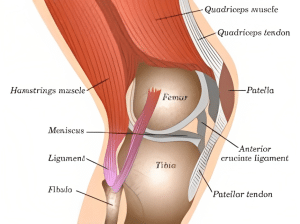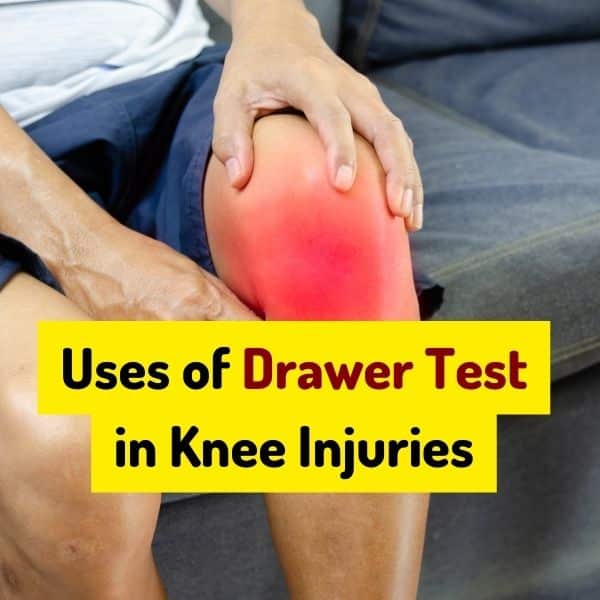The Drawer Test is an essential orthopedic assessment procedure used to assess the integrity of the knee’s anterior and posterior cruciate ligaments (ACL and PCL). When a force is applied, the anterior or posterior displacement of the tibia (shin bone) relative to the femur (thigh bone) is measured. In this post, we will go over the anatomy, biomechanics, interpretation of results, treatment choices, and the Drawer Test preventive techniques
What is Drawer Test?
The Drawer Test is a common orthopedic assessment test used to assess knee joint stability. The anterior drawer test evaluates the anterior cruciate ligament (ACL) in the knee and the anterior talofibular ligament (ATFL) in the ankle. The posterior drawer test evaluates the posterior cruciate ligament (PCL) in the knee. The tibia is moved relative to the femur and the degree of movement or “drawer” motion is assessed in this test.
History of Drawer Test
Henri Pierre Marie Parinaud first described the anterior drawer test in 1879 to assess ankle joint stability. Later, in the 1970s, the test was modified and applied to the knee joint to assess ACL damage. In the 1980s, the posterior drawer test was developed to assess PCL injuries.
Importance of Drawer Test in Orthopedics
The Drawer Test is an important examination technique in orthopedics, especially for identifying ligamentous injuries in the knee joint. It assists doctors in determining the extent of an injury, guiding treatment decisions, and monitoring the healing process.
Anatomy of Knee Joint

The femur, tibia, and patella (kneecap) make up the knee joint. The anterior cruciate ligament (ACL), posterior cruciate ligament (PCL), medial collateral ligament (MCL), and lateral collateral ligament (LCL) stabilize it. These ligaments act together to stabilize the knee joint and prevent excessive movement.
Biomechanics of Knee Joint
The knee joint is a hinge joint that can bend and extend. It also has a slight rotational movement. The ACL and PCL are in charge of preventing anterior and posterior tibial translation, respectively.
How Drawer Test Works?
The patient rests supine with the knee flexed at a 90-degree angle during the Drawer Test. The examiner uses one hand to stabilize the thigh and the other to hold the lower leg. A forward or backward push is delivered to the lower leg while keeping an eye out for any abnormal movement of the tibia in relation to the femur.
When is Drawer Test Indicated?
The Drawer Test is used when a patient has symptoms of knee instability or pain, especially after a catastrophic injury. It is frequently used to determine ACL and PCL damage.
When to Avoid Drawer Test?
In patients with acute knee injuries, considerable pain and edema, or limited range of motion, the Drawer Test should be avoided. It should also be avoided in patients who have had knee surgery in the past, as it may cause additional damage to the knee joint.
How to Perform Drawer Test?
Pre-Test Preparations
The patient should be comfortable and the knee joint should be relaxed before doing the Drawer Test. The examiner should describe the procedure to the patient and ensure that the patient understands what is going to happen.
Steps to Perform the Anterior Drawer Test:
- The patient should lie on their back on a firm surface with their knee flexed to 90 degrees and their foot flat on the surface.
- The examiner should sit on the patient’s foot to stabilize it.
- The examiner should place their thumbs on the tibial plateau just below the joint line and their fingers on the patient’s calf.
- The examiner should then draw the tibia forward, feeling for any anterior translation.
- The amount of anterior translation should be compared to the opposite leg.
- The test should be repeated with the knee in slight external rotation, which places more stress on the lateral ligaments.
- The test can also be repeated with the knee in slight internal rotation, which places more stress on the medial ligaments.
Steps to Perform Posterior Drawer Test
The Posterior Drawer test is used to assess the integrity of the posterior cruciate ligament (PCL). Here are the steps to perform the test:
- Position the patient: Ask the patient to lie down on their back with their knees flexed at 90 degrees and their feet flat on the examination table.
- Stabilize the thigh: Sit on the foot of the examination table and stabilize the patient’s thigh with your non-dominant hand just above the knee joint.
- Grasp the lower leg: With your dominant hand, grasp the patient’s lower leg just below the knee joint.
- Apply posterior force: Pull the patient’s lower leg towards you, applying a posterior force.
- Look for excessive movement: Observe the movement of the tibia relative to the femur. If there is excessive posterior movement of the tibia, it indicates a PCL injury.
- Repeat the test: Repeat the test with the patient’s knees flexed at 70 degrees and at full extension to assess different degrees of PCL laxity.
It’s important to note that this test should not be performed if there is any suspicion of a fracture or dislocation.
Interpretation of Drawer Test
Positive Drawer Test
A positive drawer test indicates knee joint instability, meaning there is excessive movement in the knee joint. This suggests that there is damage to one or more of the knee ligaments, which could be caused by an ACL, PCL, or meniscus tear.
Negative Drawer Test
On the other hand, a negative drawer test means that there is no excessive movement or looseness of the knee joint. This indicates that the knee joint is stable and intact. However, it is important to note that a negative test does not necessarily mean there is no knee injury or instability. Other diagnostic tests and evaluations may be needed to fully assess the knee joint.
Degree of Knee Joint Instability
The degree of knee joint instability can be classified into three grades:
- Grade I: A small amount of movement, indicating a mild sprain or strain.
- Grade II: A moderate amount of movement, indicating a partial tear of a ligament.
- Grade III: A significant amount of movement, indicating a complete tear of a ligament.
Specificity and Sensitivity
The specificity and sensitivity of the drawer test vary depending on the joint, the degree of flexion, and the presence of other signs. According to some sources, here are some values for the specificity and sensitivity of the drawer test:
Anterior drawer test of the knee:
specificity ranges from 0.86 to 1.0, and sensitivity ranges from 0.18 to 0.92.
Posterior drawer test of the knee:
specificity is 0.99, sensitivity is 0.90.
Specificity is the ability of a test to correctly identify those without the condition (true negative rate), while sensitivity is the ability of a test to correctly identify those with the condition (true positive rate).
Differential Diagnosis of Knee Instability
The drawer test is just one of the diagnostic tools used to diagnose knee instability. There are several different injuries that can cause knee joint instability, including:
ACL Tear
An ACL tear is a common knee injury that occurs when the ACL ligament is stretched or torn. This injury can cause the knee joint to feel unstable, and may also cause pain and swelling.
PCL Tear
A PCL tear is less common than an ACL tear, but still, a serious injury that can cause knee joint instability. It occurs when the PCL ligament is stretched or torn, and can cause pain, swelling, and difficulty walking or standing.
Meniscus Tear
A meniscus tear is a common knee injury that occurs when the meniscus cartilage is torn. This injury can cause knee joint instability, as well as pain, swelling, and difficulty moving the knee joint.
Differences Between Drawer Test Vs Lachman Test
| Drawer Test | Lachman Test |
|---|---|
| Assesses both ACL and PCL | Primarily assesses the ACL |
| Uses a forward and backward force | Uses a forward force |
| Performed with the knee flexed at 90 degrees | Performed with the knee flexed at 20-30 degrees |
| A positive result indicates partial or complete ACL tear | A positive result indicates a partial or complete ACL tear |
| May be less accurate in acute injuries | Generally considered more accurate in diagnosing ACL injuries |
Drawer Test Vs McMurray Test
| Test | Drawer Test | McMurray Test |
|---|---|---|
| Purpose | To assess knee joint stability | To assess for meniscal tears |
| Movement | Anterior-posterior (front-back) | Medial-lateral (inside-outside) or lateral-medial (outside-inside) |
| Position | Supine (lying on back) or seated | Supine (lying on back) or seated |
| Procedure | The examiner pulls and pushes the tibia | The examiner rotates and extends the knee while applying pressure |
| Positive Test | Abnormal movement of the tibia | Clicking or popping sound over the meniscus |
| Indicates | Possible ligamentous instability | Possible meniscal tear |
| Diagnostic Use | ACL, PCL, or collateral ligament injuries | Meniscal tears |
Note that the McMurray Test can assess for tears in either the medial or lateral meniscus depending on the direction of rotation, whereas the Drawer Test is primarily used to assess ligamentous instability.
Treatment Options for Knee Instability
The treatment options for knee instability depend on the severity of the injury. Here are some of the most common treatment options:
Non-Surgical Treatment
Mild to moderate knee injuries may be treated with non-surgical options, such as rest, ice, compression, and elevation (RICE). Physical therapy and bracing may also be recommended.
Surgical Treatment
Severe knee injuries may require surgery to repair or reconstruct the damaged ligament or cartilage. Surgery may involve the use of screws, pins, or other hardware to stabilize the joint.
Rehabilitation and Recovery
Following any type of knee injury, rehabilitation, and recovery are crucial to restore function and prevent future injuries. A physical therapist can help develop a rehabilitation program that includes exercises to restore strength, flexibility, and range of motion.
Prevention of Knee Injuries through Proper Training and Conditioning
Preventing knee injuries is always preferable to treating them. Proper training and conditioning can help reduce the risk of knee injuries in both athletes and the general population.
Training for Athletes
Athletes should focus on injury prevention by incorporating exercises that strengthen the muscles and ligaments around the knee joint. Exercises such as squats, lunges, and leg presses can help build strength and stability in the knee joint.
Preventive Strategies for General Population
For the general population, maintaining a healthy weight, staying active, and avoiding activities that put excessive stress on the knee joint can help prevent knee injuries. Wearing appropriate footwear and using proper form during exercise can also help reduce the risk of injury.
Conclusion
Finally, the drawer test is a useful diagnostic technique for evaluating knee joint stability and diagnosing various knee ailments, including ACL and PCL tears. An accurate diagnosis, management, and rehabilitation of knee problems require a thorough understanding of anatomy, biomechanics, indications, contraindications, and drawer test results. Individuals can reduce their risk of knee injuries and enhance their overall knee joint health by using preventive techniques such as regular exercise and conditioning.
FAQ
What is the purpose of the drawer test?
The purpose of the drawer test is to assess the degree of knee joint instability, particularly in cases of ACL and PCL tears.
Who can perform a drawer test?
The Drawer test should only be performed by a trained healthcare provider, such as an orthopedic surgeon, sports medicine physician, or physical therapist.
Is the drawer test painful?
The Drawer test can be uncomfortable for some patients, but it should not be painful. If you experience pain during the test, inform your healthcare provider immediately.
Can I prevent knee injuries through proper training and conditioning?
Yes, appropriate training and fitness can aid in the prevention of knee ailments such as ACL and PCL rupture. Knee injuries can be reduced by strengthening the muscles around the knee joint, improving flexibility and balance, and utilizing suitable techniques during physical exercise.
Is the drawer test painful?
The test can be uncomfortable for some patients, but it should not be painful. If you experience pain during the test, inform your healthcare provider immediately.
How is knee instability treated?
The treatment options for knee instability depend on the severity of the injury and may include non-surgical options, such as rest, ice, compression, and elevation, or surgical options to repair or reconstruct damaged ligaments or cartilage. Rehabilitation and recovery are also crucial to restore function and prevent future injuries.
What’s the difference between the anterior and posterior drawer tests?
Anterior and posterior drawer tests differ in the direction of force applied to assess knee joint stability. The anterior drawer test evaluates ACL integrity, while the posterior drawer test evaluates PCL integrity.
Is a positive drawer test always indicative of a knee injury?
A positive drawer test indicates knee joint instability but doesn’t necessarily mean knee injury. Further diagnostic tests may be needed to determine the cause and extent of instability.
Can a drawer test be performed on someone with a knee replacement?
Drawer test isn’t performed on individuals with knee replacements as the prosthetic implant can affect the results. Imaging studies are used instead to assess knee joint stability.
What’s the recovery time for a knee injury requiring surgery?
The recovery time for knee injury surgery varies based on the type and severity of the injury but generally takes several months. Physical therapy and rehabilitation are critical for recovery.
Can knee injuries be prevented in older adults?
Knee injuries can be prevented in older adults by maintaining a healthy weight, staying active, and avoiding activities that stress the knee joint. Exercise programs focused on improving strength, flexibility, and balance can also help reduce the risk of knee injuries in this population.
Latest Posts
- Understanding Leptospirosis: A Comprehensive Guide to Animal Health in 2024

- Ultimate Guide to Life Expectancy of PNH Disease and Key Factors: Mastering PNH Understanding

- Understanding Hunter Syndrome: A Comprehensive Guide to a Rare Genetic Disorder in 2024

- Pentasomy X Syndrome: A Comprehensive Guide for Patients and Researchers in 2024

- Tips for Getting Better Sleep with Anxiety in 2024

